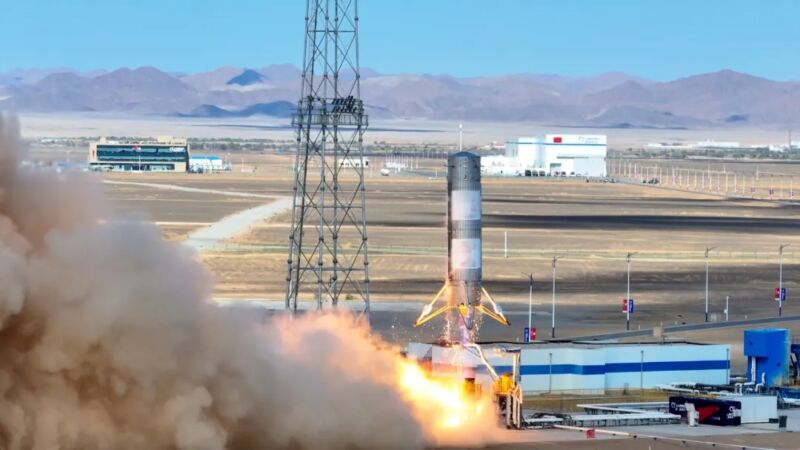Welcome to Version 7.11 of the Rocket Report! Exterior of corporations owned by American billionaires, essentially the most imminent developments in reusable rockets are coming from China’s quasi-commercial launch business. This business is now not nascent. After initially counting on solid-fueled rocket motors apparently derived from Chinese language army missiles, China’s privately funded launch corporations are testing bigger launchers, with various levels of success, and now performing hop checks harking back to SpaceX’s Grasshopper and F9R Dev1 packages greater than a decade in the past.
As at all times, we welcome reader submissions. In the event you do not wish to miss a problem, please subscribe utilizing the field under (the shape won’t seem on AMP-enabled variations of the location). Every report will embody info on small-, medium-, and heavy-lift rockets in addition to a fast look forward on the subsequent three launches on the calendar.
Landspace hops nearer to a reusable rocket. Chinese language personal house startup Landspace has accomplished a 10-kilometer (33,000-foot) vertical takeoff and vertical touchdown check on its Zhuque-3 (ZQ-3) reusable rocket testbed, together with a mid-flight engine reignition at close to supersonic circumstances, Aviation Week & Area Know-how studies. The 18.3-meter (60-foot) automobile took off from the Jiuquan launch base in northwestern China, ascended to 10,002 meters, after which made a vertical descent and achieved an on-target propulsive touchdown 3.2 kilometers (2 miles) from the launch pad. Notably, the rocket’s methane-fueled variable thrust engine deliberately shutdown in flight, then reignited for descent, as engines would function on future full-scale booster flybacks. The check booster used grid fins and chilly fuel thrusters to regulate itself when its predominant engine was dormant, in keeping with Landspace.
“All indicators met the anticipated design” … Landspace hailed the check as a serious milestone within the firm’s highway to flying its subsequent rocket, the Zhuque-3, as quickly as subsequent yr. With 9 methane-fueled predominant engines, the Zhuque-3 will initially be capable to ship 21 metric tons (46,300 kilos) of payload into low-Earth orbit with its booster flying in expendable mode. In 2026, Landspace goals to start recovering Zhuque-3 first stage boosters for reuse. Landspace is one among a number of Chinese language corporations working significantly on reusable rocket designs. One other Chinese language agency, Deep Blue Aerospace, says it plans a 100-kilometer (62-mile) suborbital check of a reusable booster quickly, forward of the primary flight of its medium-class Nebula-1 rocket subsequent yr. (submitted by Ken the Bin)
Isar Aerospace units low bar for achievement on first launch. Daniel Metzler, CEO of German launch startup Isar Aerospace, acknowledged that the primary flight of the Spectrum rocket can be a hit if it didn’t destroy the launch web site, European Spaceflight studies. Throughout an interview on the Handelsblatt innovation convention, Metzler was requested what he would think about a profitable inaugural flight of Spectrum. “For me, the primary flight might be a hit if we don’t blow up the launch web site,” defined Metzler. “That might most likely be the factor that might set us again essentially the most when it comes to know-how and time.” This tempering of expectations sounds remarkably much like statements made by Elon Musk about SpaceX’s first flight of the Starship rocket final yr.
Within the catbird seat? … Isar Aerospace might be ready to develop into the primary in a brand new crop of European industrial launch corporations to aim its first orbital flight. One other German firm, Rocket Manufacturing unit Augsburg, not too long ago gave up on a doable launch this yr after the booster for its first launch caught fireplace and collapsed throughout a check at a launch web site in Scotland. Isar plans to launch its two-stage Spectrum rocket, designed to hold as much as 1,000 kilograms (2,200 kilos) of payload into low-Earth orbit, from Andøya Spaceport in Norway. Isar hasn’t publicized any schedule for the primary flight of Spectrum, however there are indications the publicity-shy firm is testing {hardware} on the Norwegian spaceport. (submitted by Ken the Bin)
FAA to introduce new orbital particles guidelines. The Federal Aviation Administration is transferring forward with efforts to develop guidelines for the disposal of higher phases as one other Centaur higher stage breaks aside in orbit, Area Information studies. The FAA launched draft laws on the matter for public remark one yr in the past, and the top of the company’s industrial spaceflight division not too long ago stated the foundations are a “excessive precedence for our group.” The foundations would direct launch operators to eliminate higher phases in one among 5 methods, from managed reentries to placement in graveyard or “disposal” orbits not generally utilized by operational satellites. One change the FAA would possibly make to the draft guidelines is to cut back the required timeline for an uncontrolled reentry of a disposed higher stage from not more than 25 years to a shorter timeline. “We bought plenty of feedback that stated it must be quite a bit much less,” stated Kelvin Coleman, head of the FAA’s industrial spaceflight workplace. “We’re taking that into consideration.”
Higher phases are an issue … A number of current breakups involving spent higher phases in orbit have highlighted the priority that useless rocket our bodies may create pointless house junk. Final month, the higher stage from a Chinese language Lengthy March 6A disintegrated in low-Earth orbit, creating at the very least 300 items of house particles. Extra not too long ago, a Centaur higher stage from a United Launch Alliance Atlas V rocket broke aside in a a lot greater orbit, leading to greater than 40 items of particles. This was the fourth time one among ULA’s Centaur higher stage has damaged up since 2018. (submitted by Ken the Bin)
